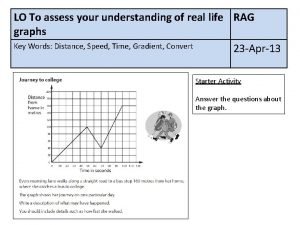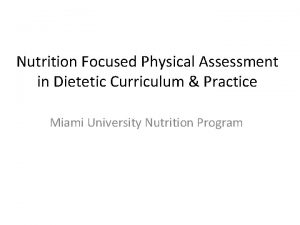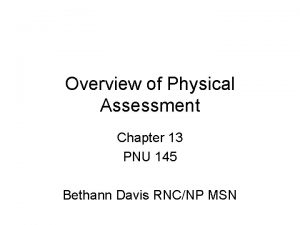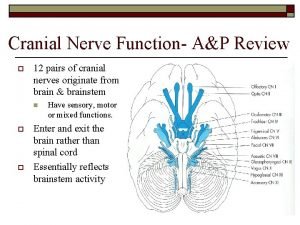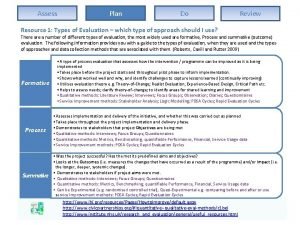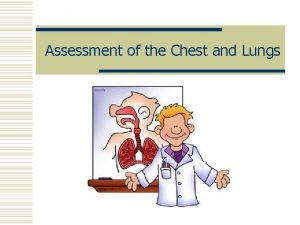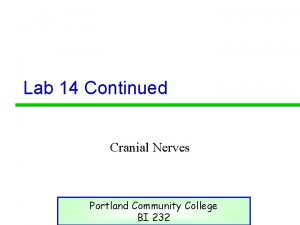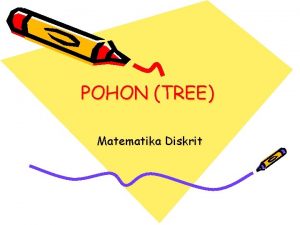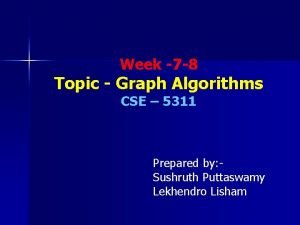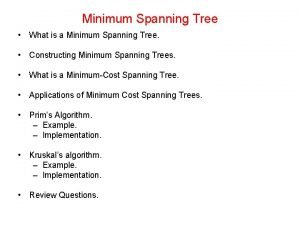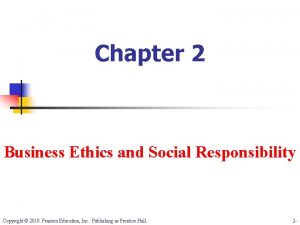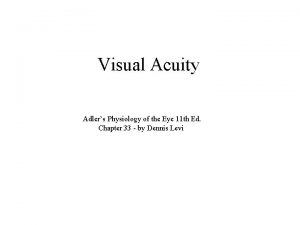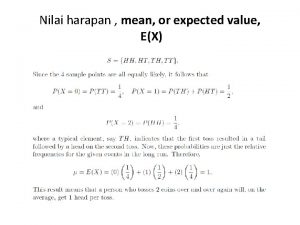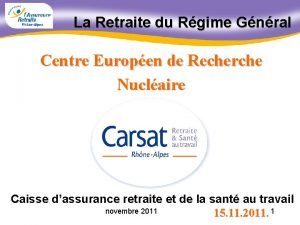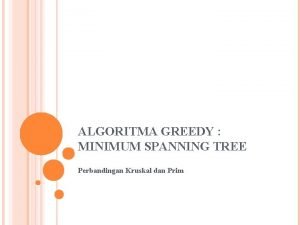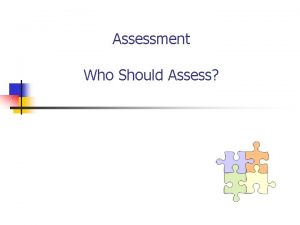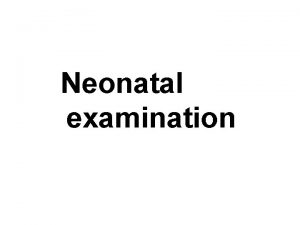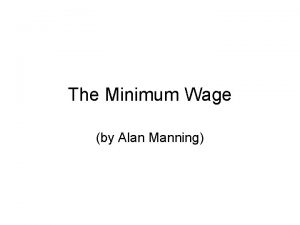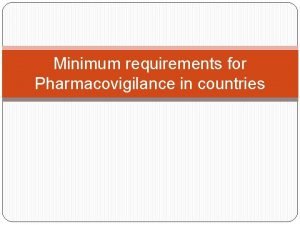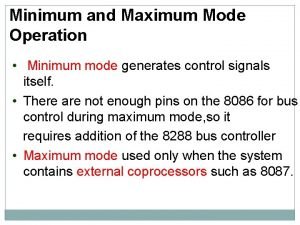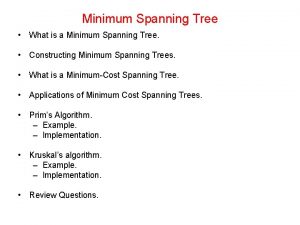Interaction Note to assess interaction a minimum of
























































- Slides: 56

Interaction

Note: to assess interaction, a minimum of 3 variables were needed in this study: • Aspirin • Anger • Coronary Heart Disease (CHD) Interaction = “Effect modification”: The “effect” of the risk factor -- anger – on the outcome – CHD -- differs depending on the presence or absence of a third factor (effect modifier) --aspirin. The third factor (aspirin) modifies the effect of the risk factor (anger) on the outcome (CHD). Aspirin Anger CHD

How is “effect”* measured in epidemiologic studies? • If effect is measured on an additive or absolute scale (attributable risks) additive interaction assessment (Attributable Risk model). • If effect is measured on a relative (ratio) scale (relative risks, odds ratios, etc. ) multiplicative interaction assessment (Relative Risk model). *For practical purposes in this lecture, “effect” refers to associations that may or may not be causal.

Two strategies to evaluate interaction based on different, but equivalent definitions: • Effect modification (homogeneity/heterogeneity of effects) • Comparison between joint expected and joint observed effects

First strategy to assess interaction: Effect Modification ADDITIVE (attributable risk) interaction Hypothetical example of absence of additive interaction Z A No No 10. 0 Yes 20. 0 No 30. 0 Yes 40. 0 Yes Incidence rate (%) ARexp to A (%) Potential effect modifier Potential risk factor of primary interest

First strategy to assess interaction: Effect Modification ADDITIVE (attributable risk) interaction Hypothetical example of absence of additive interaction Z A No No 10. 0 Yes 20. 0 No 30. 0 Yes 40. 0 Yes Incidence rate (%) ARexp to A (%) 10. 0 Conclude: Because AR’s associated with A are not modified by exposure to Z, there is no additive interaction.

First strategy to assess interaction: Effect Modification ADDITIVE (attributable risk) interaction Hypothetical example of presence of additive interaction Z A Incidence rate (%) No No 5. 0 Yes 10. 0 No 10. 0 Yes ARexp to A (%) 5. 0 20. 0 Yes 30. 0 Conclude: Because AR’s associated with A are modified by exposure to Z, additive interaction is present.

Absolute scale Example 1 Z+ Z- Example 2 ARA ARA Z+ Z- ARA Conclude: -The stratum-specific effects (AR) are homogeneous -The stratum-specific effects (AR) are heterogeneous - Z does not modify the effect of A - Z modifies the effect of A -There is no (additive) interaction -There is (additive) interaction

Example of Effect Modification (Interaction) in a Clinical Trial with a Continuous Outcome From: Szklo, Arch Dermatol 2000; 136: 1546 (Based on Gallagher et al, 2000)

35 30 New Nevi, No. 25 Sunscr < Cont Sunscr << Cont 20 15 10 5 Sunscreen Control 0 5 10 20 Freckles, % 30 40 Example of Freckling as an Interacting Variable (Effect Modifier) From: Szklo, Arch Dermatol 2000; 136: 1546 (Based on Gallagher et al, 2000)

First strategy to assess interaction: Effect Modification MULTIPLICATIVE (ratio-based) interaction Hypothetical example of absence of multiplicative interaction Z A Incidence rate (%) No No 10. 0 Yes 20. 0 No 25. 0 Yes 50. 0 Yes RRA 2. 0 Conclude: Because RR’s associated with A are not modified by exposure to Z, there is no multiplicative interaction.

First strategy to assess interaction: Effect Modification MULTIPLICATIVE (ratio-based) interaction Hypothetical example of presence of multiplicative interaction Z A Incidence rate (%) No No 10. 0 Yes 20. 0 No 25. 0 Yes 125. 0 Yes RRA 2. 0 5. 0 Conclude: Because RR’s associated with A are modified by exposure to Z, multiplicative interaction is present.

Example 1 Example 2 Incidence rate (%) 140 120 100 80 60 40 20 0 Z+ Z- A- A+ Is this the best way to display the data? NO!

To assess multiplicative effects, use a log scale: Example 1 Example 2 Z+ Z+ Z- Z- Conclude: -The stratum-specific effects (RR) are homogeneous -The stratum-specific effects (RR) are heterogeneous - Z does not modify the effect of A - Z modifies the effect of A -There is no (multiplicative) interaction -There is (multiplicative) interaction

Two strategies to evaluate interaction based on different, but equivalent definitions: • Effect modification (homogeneity/heterogeneity of effects) • Comparison between joint expected and joint observed effects

Second strategy to assess interaction: (based on the calculation of “joint effects”) Individual effects A + Z Expected joint effect Observed joint effect A+Z No interaction Observed joint effect A+Z +I Synergism (Positive Interaction) Observed joint effect A+Z -I Antagonism (Negative Interaction)

The two definitions and strategies are completely equivalent. It is impossible to conclude that there is (or there is not) interaction using one strategy, and reach the opposite conclusion upon use of the other strategy! Thus, when there is effect modification, the joint observed and the joint expected effects will be different.

Second strategy to assess interaction: comparison of joint expected and joint observed effects Additive interaction Reference

Second strategy to assess interaction: comparison of joint expected and joint observed effects Additive interaction Independent effects of: Reference 10. 0 A 20. 0 Z 30. 0 A + Z

Second strategy to assess interaction: comparison of joint expected and joint observed effects Additive interaction Reference 10. 0 20. 0 30. 0 Joint observed ARA+Z+ = 30% Joint expected ARA+Z+ = ARA+Z- + ARA-Z+= 30% Conclude: Because the observed joint AR is the same as that expected by adding the individual AR’s, there is no additive interaction (that is, the same conclusion as when looking at the stratified AR’s)

Second strategy to assess interaction: comparison of joint expected and joint observed effects Additive interaction Expected Reference 5. 0 25. 0 10. 0 Joint observed AR = 25% Joint expected AR = ARA+Z- + ARA-Z+= 10% Conclude: Because the observed joint AR is different from that expected by adding the individual AR’s, additive interaction is present (that is, the same conclusion as when looking at the stratified AR’s)

Second strategy to assess interaction: comparison of joint expected and joint observed effects Multiplicative interaction Reference 2. 0 2. 5 5. 0 Joint observed RRA+Z+ = 5. 0 Joint expected RRA+Z+ = RRA+Z- RRA-Z+= 2. 0 2. 5 = 5. 0 Conclude: Because the observed joint RR is same as that expected by adding the individual RR’s in a multiplicative scale (equivalent to multiplying the individual RR’s), multiplicative interaction is not present(that is, the same conclusion as when looking at the stratified RR’s)

Second strategy to assess interaction: comparison of joint expected and joint observed effects Multiplicative interaction Reference 2. 0 2. 5 12. 5 5. 0 Joint observed RRA+Z+ = 12. 5 Joint expected RRA+Z+ = RRA+Z- RRA-Z+= 2. 0 2. 5 = 5. 0 Conclude: Since the observed joint RR is different from that expected by multiplying the individual RR’s, there is multiplicative interaction (that is, the same conclusion as when looking at the stratified RR’s)

How can we assess interaction in case-control studies?

Case-control study First strategy to assess interaction: Effect Modification Additive interaction cannot be assessed in case-control studies by using the effect modification (homogeneity/heterogeneity) strategy, as no incidence rates are available to calculate attributable risks in the exposed Prospective Study Z A No No 5. 0 Yes 10. 0 No 10. 0 Yes 30. 0 Yes Incidence rate (%) ARexp to A (%) 5. 0 20. 0

Case-control study First strategy to assess interaction: Effect Modification Layout of table to assess MULTIPLICATIVE interaction

Odds Ratios for the association among isolated clubfoot, maternal smoking, and a family history of clubfoot, Atlanta, Georgia, 1968 -80 Family history of clubfoot Yes No Maternal smoking Cases Controls Yes 14 7 No 11 20 Yes 118 859 No 203 2, 143 Honein et al. Family history, maternal smoking, and clubfoot: an indication of gene-environment interaction. Am J Epidemiol 2000; 152: 658 -65. Hypothesis: Family History is a potential effect modifier of the association between Maternal Smoking and clubfoot Use the first strategy (homogeneity/heterogeneity) to evaluate the presence of multiplicative interaction

Family history of clubfoot Maternal smoking Cases Controls Stratified ORmaternal smk Yes 14 7 3. 64 No 11 20 Yes 118 859 No 203 2, 143 Yes re fer en ce Odds Ratios for the association among isolated clubfoot, maternal smoking, and a family history of clubfoot, Atlanta, Georgia, 1968 -80 No 1. 45 Honein et al. Family history, maternal smoking, and clubfoot: an indication of geneenvironment interaction. Am J Epidemiol 2000; 152: 658 -65. Conclude: Since the stratified ORs are different (heterogeneous), there is multiplicative interaction. Now evaluate the same hypothesis (that there is an interaction between family history of clubfoot and maternal smoking) using the second strategy: comparison between joint observed and joint expected “effects”.

Case-control study Second strategy to assess interaction: comparison of joint observed and expected effects Layout of table to assess both ADDITIVE and MULTIPLICATIVE interaction Note common reference category OR-+ OR+OR++ Under ADDITIVE MODEL: Exp’d OR++ = OR+- + OR-+ - 1. 0

Derivation of formula for expected joint OR expected RR++ 1. 0 RR+- observed 1. 0 RR-+ If disease is “rare” (e. g. , <5%): 1. 0

Derivation of formula: Expected OR++ = OR+- + OR-+ - 1. 0 Intuitive graphical derivation: * OR 3. 5 2. 0 2. 5 EXCZ EXCA 1. 0 EXCZ BL BL OR-- OR-+ OR+- Exp’d OR++ Baseline+Excess due to A = Baseline+Excess due to Z [EXCA+BL] + [EXCZ+BL] - BL OR-+ + OR+- – 1. 0 *For a more formal derivation, see Szklo & Nieto, pp. 229 -230 (not required).

OR Observed OR++ 3. 5 2. 0 3. 5 2. 5 1. 0 OR-- OR-+ OR+- Exp’d OR++ Conclude: If the observed joint OR is the same as the expected under the additive model, there is no additive interaction

Observed OR++ 6. 0 OR 3. 5 2. 0 2. 5 Excess due to the joint effects of A and Z 1. 0 OR-- OR-+ OR+- Excess due to interaction (“interaction term”) Exp’d OR++ Conclude: If the observed joint OR is different than the expected under the additive model, there is additive interaction

Second Strategy: Comparison between joint expected and joint observed effects -allows assessment of both ADDITIVE and MULTIPLICATIVE interactions-Odds Ratios for the association among isolated clubfoot, maternal smoking, and a family history of clubfoot, Atlanta, Georgia, 1968 -80 Family history of clubfoot Yes No Cases Controls Stratified ORs using No/No as the reference category Yes 14 7 3. 64 20. 30 No 11 20 Yes 118 859 No 203 2, 143 Maternal smoking 5. 81 1. 45 Expected under the ADDITIVE model 6. 26 1. 45 + 5. 81 – 1. 0= 1. 0 (reference) Honein et al. Family history, maternal smoking, and clubfoot: an indication of geneenvironment interaction. Am J Epidemiol 2000; 152: 658 -65. Conclude: Since the observed joint OR(20. 3) is different from the joint OR expected under the additive model (6. 26), there is additive interaction , i. e. , in th ly n o y r o t is Family H moking S Effect of l a n r e t of Ma absence e Effect of Maternal Smoking only, i. e. , in the absence of Family History

Case-control study Second strategy to assess interaction: comparison of joint observed and expected effects Layout of table to assess both ADDITIVE and MULTIPLICATIVE interaction OR-+ OR+OR++ Under ADDITIVE MODEL: Under MULTIPLICATIVE MODEL: Exp’d OR++ = OR+- + OR-+ - 1. 0 Exp’d OR++ = OR+- OR-+

Odds Ratios for the association among isolated clubfoot, maternal smoking, and a family history of clubfoot, Atlanta, Georgia, 1968 -80 Family history of clubfoot Yes No Cases Controls Stratified ORs using No/No as the reference category Yes 14 7 3. 64 20. 30 No 11 20 Yes 118 859 No 203 2, 143 Maternal smoking 5. 81 1. 45 Expected under the MULT. model 8. 42 1. 45 5. 81 = 1. 0 (reference) Honein et al. Family history, maternal smoking, and clubfoot: an indication of geneenvironment interaction. Am J Epidemiol 2000; 152: 658 -65. Conclude: Since the observed joint OR(20. 3) is different from the joint OR expected under the multiplicative model(8. 42), there is multiplicative interaction e. , in the i. , ly n o y ily Histor m a F f o t moking S l Effec a n r e t of Ma absence Effect of Maternal Smoking only, i. e. , in the absence of Family History

Back to the terms. . . • Synergism or Synergy: The observed joint “effect” is greater than that expected from the individual “effects”. Which is equivalent to saying that the “effect” of A in the presence of Z is stronger than the “effect” of A when Z is absent. • Antagonism: The observed joint “effect” is smaller than that expected from the individual “effects”. Which is equivalent to saying that the “effect” of A in the presence of Z is weaker than the “effect” of A when Z is absent Note: the expressions “synergism/antagonism” and “effect modification” should ideally be reserved for situations in which one is sure of a causal connection. In the absence of evidence supporting causality, it is preferable to use terms such as “heterogeneity” or “positive/negative interaction”.

Terminology • Positive interaction = Synergism = “More than additive effect” (for the additive model) or “More than multiplicative effect” (for the multiplicative model) • Negative interaction = Antagonism = “Less than additive/multiplicative effect” Some investigators reserve the term “synergy” to define a biologically plausible interaction

• Quantitative vs. qualitative interaction

Odds Ratios for the association among isolated clubfoot, maternal smoking, and a family history of clubfoot, Atlanta, Georgia, 1968 -80 Family history of clubfoot Yes No Maternal smoking Cases Controls Stratified ORmaternal smk Yes 14 7 3. 64 No 11 20 Yes 118 859 No 203 2, 143 1. 45 Honein et al. Family history, maternal smoking, and clubfoot: an indication of geneenvironment interaction. Am J Epidemiol 2000; 152: 658 -65. Quantitative interaction: both ORs are in the same direction(>1. 0), but they are heterogeneous

Am J Epidemiol 1995; 142: 1322 -9 Reproductive Health Study, retrospective study of 1, 430 non-contraceptive parous women, Fishkill, NY, Burlington, VT, 1989 -90. Odds ratios are not only different; they have different directions (>1, and <1). Smoking modifies the effect of caffeine on delayed conception in a qualitative manner, i. e. , there is qualitative interaction.

When there is qualitative interaction in one scale (additive or multiplicative), it must also be present in the other Risk of outcome Z+ ZA- A+ Qualitative Interaction: Effect Modifier Risk Factor Incidence/1000 ARA RRA Z+ A+ 10. 0 +5/1000 2. 0 A- 5. 0 Reference 1. 0 A+ 3. 0 -3/1000 0. 5 A- 6. 0 Reference 1. 0 Z- Interaction in both scales

When there is qualitative interaction in one scale (additive or multiplicative), it must also be present in the other Risk of outcome Z+ ZA- A+ Qualitative Interaction: Effect Modifier Risk Factor Incidence/1000 ARA RRA Z+ A+ 10. 0 +5/1000 2. 0 A- 5. 0 Reference 1. 0 A+ 3. 0 -3/1000 0. 5 A- 6. 0 Reference 1. 0 Z-

Risk of outcome When there is qualitative interaction in one scale (additive or multiplicative), it must also be present in the other “cross-over” Z+ Z- A- A+ Another type of qualitative interaction: “effect”of A is flat in one stratum of the effect modifier; in the other stratum, an association is observed Risk of outcome Z+ ZA- A+

Example of qualitative interaction (CHD) CHD-free cumulative probabilities Circulation 2000; 101: 2034 -9 Hig h Mode rate Low Anger score: Low (10 -14) Moderate (15 -21 High (22 -40) Days of follow-up CHD event-free survival probabilities among normotensive individuals by trait anger scores CHD event-free survival probabilities among hypertensive individuals by trait anger scores Normotensive persons Anger score Age-adjusted HR of CHD: Hypertensive persons Anger score Low Moderate High 1. 00 1. 36 2. 97 1. 00 0. 88 1. 05

Further issues for discussion • Quantitative vs. qualitative interaction • Reciprocity of interaction If Z modifies the effect of A on disease Y, then Z will necessarily modify the effect of Z on disease Y

Reciprocity of interaction The decision as to which is the “principal” variable and which is the effect modifier is arbitrary, because if A modifies the effect of Z, then Z modifies the effect of A A modifies the effect of Z

INTERACTION IS NOT CONFOUNDING Matched case-control study (matching by gender) of the relationship of risk factor X (e. g. , alcohol drinking ) and disease Y (e. g. , esophageal cancer) Pair No. Case Control 1 (male) + - 2 (male) + - 3 (male) - + 4 (male) + - 5 (male) + + 6 (female) - - 7 (female) + - 8 (female) - + 9 (female) + + 10 (female) - - Total (Pooled) Odds Ratio OR by gender

INTERACTION IS NOT CONFOUNDING Matched case-control study (matching by gender) of the relationship of risk factor X (e. g. , alcohol drinking ) and disease Y (e. g. , esophageal cancer) Pair No. Case Control 1 (male) + - 2 (male) + - 3 (male) - + 4 (male) + - 5 (male) + + 6 (female) - - 7 (female) + - 8 (female) - + 9 (female) + + 10 (female) - - Total (Pooled) Odds Ratio OR by gender 4/2= 2. 0

INTERACTION IS NOT CONFOUNDING Matched case-control study (matching by gender) of the relationship of risk factor X (e. g. , alcohol drinking ) and disease Y (e. g. , esophageal cancer) Pair No. Case Control 1 (male) + - 2 (male) + - 3 (male) - + 4 (male) + - 5 (male) + + 6 (female) - - 7 (female) + - 8 (female) - + 9 (female) + + 10 (female) - - Total (Pooled) Odds Ratio OR by sex 3/1 = 3. 0 1/1= 1. 0 4/2= 2. 0

Further issues for discussion • • • Quantitative vs. qualitative interaction Reciprocity of interaction Interpretation and uses of interaction – Additive interaction as “public health interaction” (term coined by Rothman)

Joint effects of current cigarette smoking and low consumption of vitamin C (≤ 100 mg/day) with regard to adenocarcinoma of the salivary gland, San Francisco-Monterey Bay area, California, 1989 -1993 Current Smoking Status Low Vitamin C intake (mg/day) Odds Ratio No No 1. 0 Yes No 6. 8 No Yes 1. 8 Yes 10. 6 (Horn-Ross et al. Diet and risk of salivary gland cancer. Am J Epidemiol 1997; 146: 171 -6) on= i t c tera n” Additive Model: n i itive eractio d d Expected joint Odds Ratio = 6. 8 + 1. 8 – 1. 0= 7. 6 e a lth int v ion i t t i a c s ra Po lic He e t b n “Pu ei v i t ica l p i ult m Multiplicative Model: tive a Expected joint Odds Ratio = 6. 8 1. 8 = 12. 4 Neg Conclude: For Public Health purposes, ignore negative multiplicative interaction, and focus on smokers for prevention of low vitamin C intake

Additive interaction as “Public Health interaction” Incidence of disease “Y” by smoking and family history of “Y” EM- effect modifier RF- risk factor of interest Positive additive interaction (synergism), but negative multiplicative interaction (antagonism) Thus, if there are enough subjects who are positive for both variables and if resources are limited, smokers with a positive family history should be regarded as the main “target” for prevention examine the prevalence of (Fam HIst+ and Smk+ ) and estimate the attributable risk in the population

Further issues for discussion • • • Quantitative vs. qualitative interaction Reciprocity of interaction Interpretation and uses of interaction – Additive interaction as “public health interaction” – Biological interaction

Further issues for discussion • Quantitative vs. qualitative interaction • Reciprocity of interaction • Interpretation and uses of interaction – Additive interaction as “public health interaction” – Biological interaction – Statistical interaction (not causal) • Differential confounding across strata of the effect modifier • Differential misclassification across strata of the effect modifier • The dose (amount of exposure) may be higher in one stratum than in the other • Biologic interaction: – Consistent with pathophysiologic mechanisms (biologic plausibility) – Confirmed by animal studies – What is best model from the biologic viewpoint? No one knows for sure… Think about the specific condition under study – Examples: trauma, cancer Problem: Epidemiology usually assesses proximal cause X 1 X 2 X 3 Y

Conclusion • If heterogeneity is present… is there interaction? – What is the magnitude of the difference? (p-value? ) – Is it qualitative or just quantitative? – Is it biologically plausible? • If we conclude that there is interaction, what should we do? – Report the stratified measures of association … The interaction may be the most important finding of the study!
 Absolute maximum and minimum
Absolute maximum and minimum Signal words example
Signal words example What is debit note and credit note
What is debit note and credit note Difference between note making and note taking
Difference between note making and note taking Linear method of note taking
Linear method of note taking Financial documents in order
Financial documents in order A simple discount note results in
A simple discount note results in Difference between note making and note taking
Difference between note making and note taking What is debit note and credit note
What is debit note and credit note Block randomization
Block randomization Ask assess advise
Ask assess advise Abcd of orm
Abcd of orm Assess zihinsel beceri testi soruları
Assess zihinsel beceri testi soruları Humanistic psychologists may assess personality by
Humanistic psychologists may assess personality by Secure assess aat
Secure assess aat Why assess
Why assess Acfi behaviour charts
Acfi behaviour charts Hr planning process
Hr planning process Evolve secure access city and guilds
Evolve secure access city and guilds Assess your understanding
Assess your understanding How to assess alert and oriented
How to assess alert and oriented Nutrition focused physical exam training
Nutrition focused physical exam training Plan, do, review template
Plan, do, review template Assess your understanding
Assess your understanding Sqa solar open assess
Sqa solar open assess Tactile fremitus location
Tactile fremitus location Secureassess evolve
Secureassess evolve Assessment of student achievement 10th edition
Assessment of student achievement 10th edition Organised retail
Organised retail Assess plan act
Assess plan act Projective techniques are used to assess personality by:
Projective techniques are used to assess personality by: Techniques to assess country risk
Techniques to assess country risk How to assess alert and oriented
How to assess alert and oriented Cn 2 test
Cn 2 test Assess plan do review model
Assess plan do review model What causes tactile fremitus
What causes tactile fremitus Hypoglossal cranial nerve test
Hypoglossal cranial nerve test Hazard profile examples
Hazard profile examples What does tactile fremitus assess
What does tactile fremitus assess Formula lemeshow
Formula lemeshow Contoh soal pohon biner matematika diskrit
Contoh soal pohon biner matematika diskrit Minimum spanning tree
Minimum spanning tree Minimum cost spanning tree
Minimum cost spanning tree Moral minimum theory
Moral minimum theory Minimum cost flow
Minimum cost flow Minimum discriminable acuity
Minimum discriminable acuity Concierge mvp
Concierge mvp Expected value adalah
Expected value adalah Maunderovo minimum
Maunderovo minimum Maximum and minimum derivative
Maximum and minimum derivative How to find minimum cut
How to find minimum cut Photoshop minimum requirements
Photoshop minimum requirements Layouts that can handle varied processing requirements
Layouts that can handle varied processing requirements Carsat retraite rhone alpes
Carsat retraite rhone alpes Rumus kuasa minimum untuk mengangkat beban
Rumus kuasa minimum untuk mengangkat beban Algoritma kruskal
Algoritma kruskal Minimum slope for car ramp
Minimum slope for car ramp



















